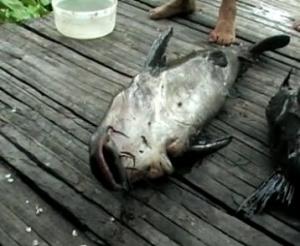Urarina Language and Culture

Landing page image for the collection ‘Urarina Language and Culture’. Click on image to access collection.
| Language | Urarina |
| Depositor | Knut Olawsky |
| Affiliation | Mirima Dawang Woorlab-gerring Language and Culture Centre, Kununurra – Since 2005 |
| Location | Peru |
| Collection ID | 0041 |
| Grant ID | IPF0001 |
| Funding Body | ELDP |
| Collection Status | Collection online |
| Landing Page Handle | http://hdl.handle.net/2196/1593741c-48ca-4345-a4d3-edef6eabe250 |
Summary of the collection
Urarina is an isolate spoken by less than 3,000 people in the area of the Rio Chambira, Loreto Province, North-western Peru. The language exhibits a range of unusual grammatical characteristics that are rarely or not at all found in other languages. While the grammar of Urarina is described in Olawsky (to appear in 2006; Mouton series), the archived materials represent the data on which this research is based.
For the overall structure and metadata for the deposit, click the bundle Urarina Archive – Metadata Overview (http://hdl.handle.net/2196/00-0000-0000-0008-2C86-D).
Group represented
The Urarina live in a number of small settlements throughout the area of the Rio Chambira and its tributaries. Until recently they have lived in relative isolation. However, there has been an increase in contact with the outside world through the establishment of oil mining operations in the Rio Chambira area, as well as the activities of missionaries and traders. This has contributed to a dramatic linguistic shift to Spanish, which has occurred in some of the Urarina communities, as well as the abandonment of a number of cultural practices. Many traditional customs have already been abandoned. These include knowledge of the production of artifacts such as blowguns and the poison used with these, the absence of previously existing musical culture, and the loss of spiritual practices.
Special characteristics
Probably the most comprehensive digital archive based on fieldwork of an Amazonian language.
From a linguistic point of view, Urarina is particularly interesting because of a range of unusual and complicated matters of its grammar. Aspects are the analysis of a complex, threefold conjugation system, the possible absence of ditransitive verbs, and the systematic omission of participants in switch reference.
Collection contents
The study was initiated by the Research Centre for Linguistic Typology (Melbourne) in 2000 and later funded by the Endangered Languages Documentation Programme (London) from mid 2003 to mid 2005. During five separate field trips between one to six months length, a range of texts were recorded and will be archived. In total, 126 texts were recorded, equalling about 17 hours of speech. While these include a wide range of different genres such as conversations, picture descriptions, instructions, and sermons, most are narratives, which can be further divided into several subtypes:
- Traditional narratives: these typically account for the Urarina worldview in terms of creation; others are stories that describe the courage of specific people in the past, most commonly in defeating groups of enemies.
- Hunting stories: in these, the storyteller describes a personal experience of his own past.
- Dramatic events experienced by others: the storyteller describes dangerous or funny events that happened during his own lifetime – mostly reproducing the second type.
- History: typically, these narratives account for the history of a village, describing how people first arrived and settled. This also includes descriptions of how the people lived in ancient times, thus not necessarily including the storyteller himself. Not all texts have been transcribed and glossed up to this stage and further research by other scholars would be welcome.
The deposit also contains music recordings, literacy materials (bilingual storybook), wordlists, and video footage. The user is advised to study the metadata (summaries, overviews, and other instructive files) before diving into this ocean of data.
Acknowledgement and citation
To refer to any data from the collection, please cite as follows:
Olawsky, Knut. 2003. Urarina Language and Culture. Endangered Languages Archive. Handle: http://hdl.handle.net/2196/00-0000-0000-0001-4EE4-8. Accessed on [insert date here].
Note that no data may be used commercially in any way. None of the materials, including excerpts, are to be distributed further without prior permission. Finally, none of the data may be modified or edited for publication without prior permission.


